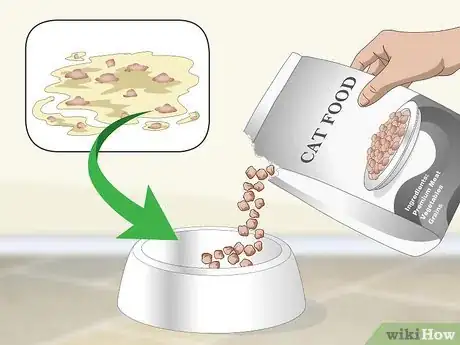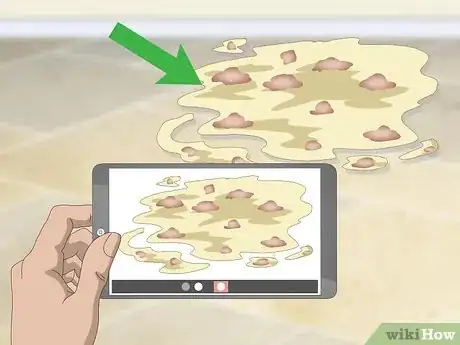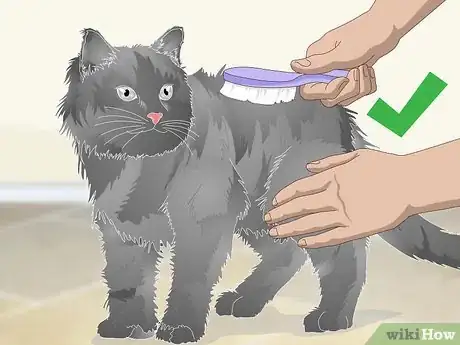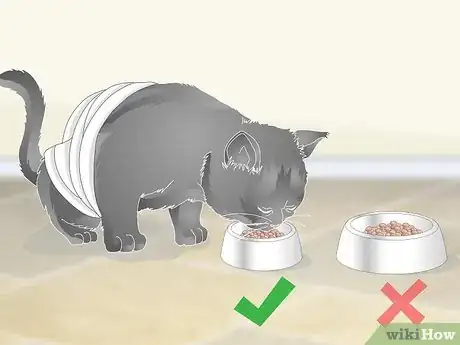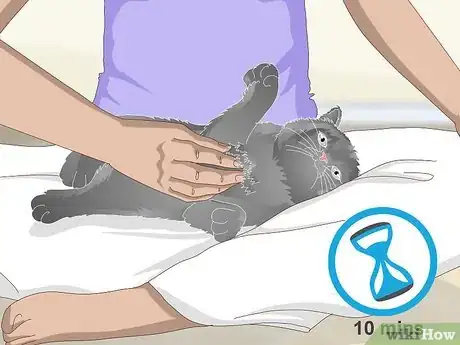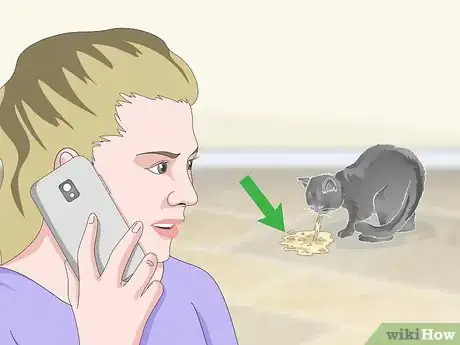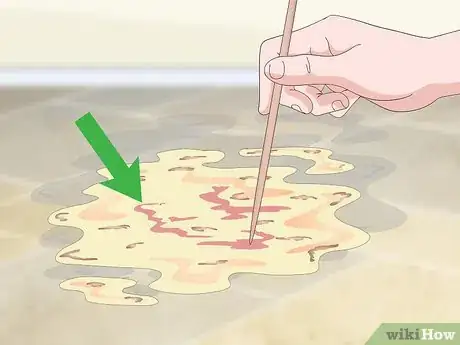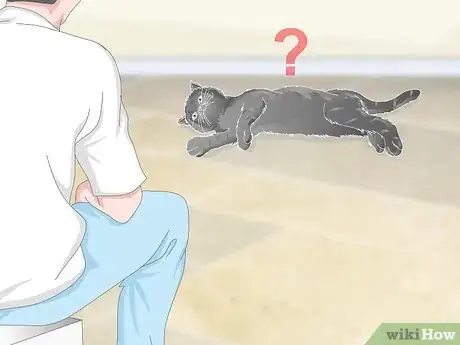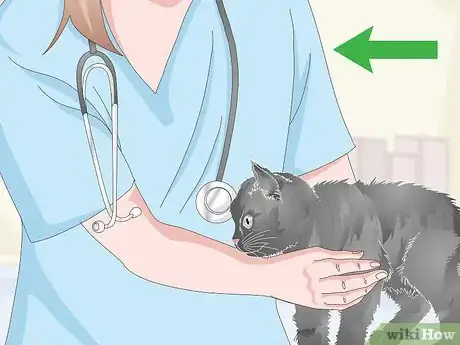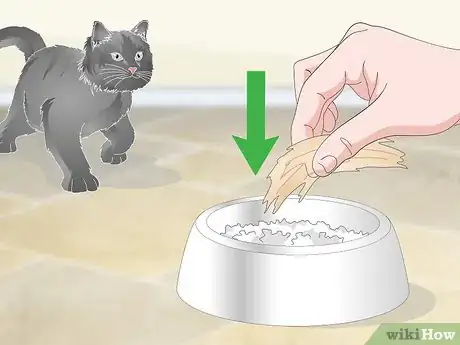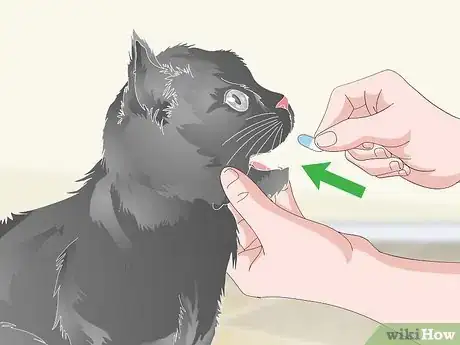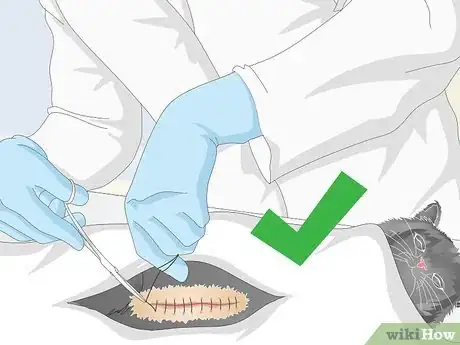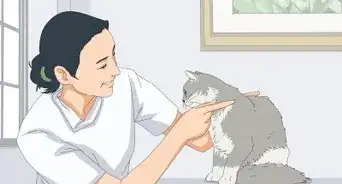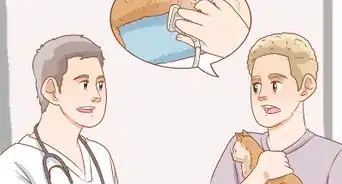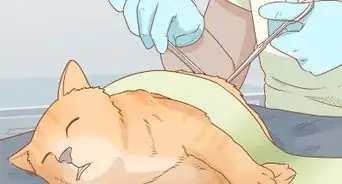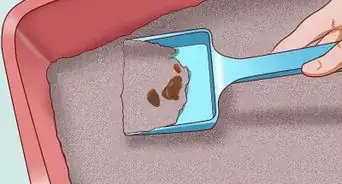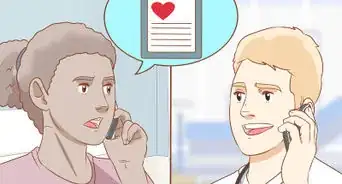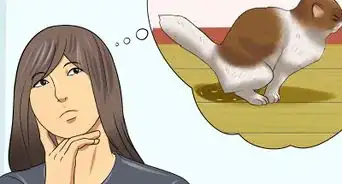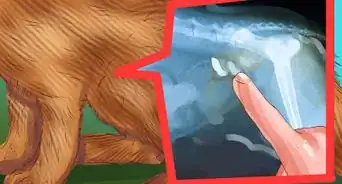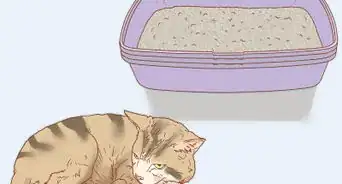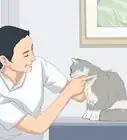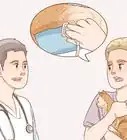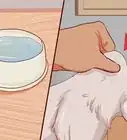This article was co-authored by Pippa Elliott, MRCVS and by wikiHow staff writer, Jessica Gibson. Dr. Elliott, BVMS, MRCVS is a veterinarian with over 30 years of experience in veterinary surgery and companion animal practice. She graduated from the University of Glasgow in 1987 with a degree in veterinary medicine and surgery. She has worked at the same animal clinic in her hometown for over 20 years.
This article has been viewed 86,587 times.
Make your vomiting cat comfortable at home if it's been vomiting. Look at your cat's vomit and pay attention to your cat's behavior. If your cat doesn't improve rapidly and you think an underlying medical condition is causing the vomiting, contact your veterinarian. After examining your pet, your vet will give you a personalized treatment plan to get your cat back on its feet.
Steps
Caring for Your Cat at Home
-
1Note any changes to your cat's diet, thirst or behavior. To determine why your cat is vomiting, think about changes to your cat's diet, thirst, and behavior. Start by remembering when and what your cat ate last. Note if your cat is drinking more or less than usual. Also, check the litter box to see how often it has been used and if the cat has diarrhea.[1]
- For example, think about if your cat just ate a lot of wet food in a short period of time. Or consider if your cat hasn't been eating much and seems overly tired.
- Note that vomiting is a symptom rather than a diagnosis, and may indicate an underlying health problem. Cats can become dehydrated easily, so if the cat vomits several times in a few hours or vomits more than 1 day in a row, take the cat to see a veterinarian.
-
2Feed your cat smaller portions if you see undigested food in the vomit. If there's undigested food in the vomit and your cat seems fine once they've thrown up, the cat might have just eaten too quickly. To prevent your cat from vomiting again after it eats, slow the cat down. Offer it smaller portions of food more frequently and spread the food out so your cat has to look for the food.[2]
- If you have more than 1 cat and can't slow it down when it eats, separate the cats when you feed them. This will let you feed them a smaller portion.
Advertisement -
3Check the color and texture of the vomit. Take pictures of the vomit to show your vet. The color, texture, and quantity of the vomit can help the vet determine what is causing it. For example, if there’s blood in the vomit it may indicate damage tot he stomach lining, while yellow bile can indicate inflammation around the bile duct.[3]
- Most cat vomit doesn't have a strong odor, but if the vomit smells like undigested food, your cat could have blocked intestines.
-
4Groom your cat every day to prevent hairballs. To keep your cat from vomiting up hairballs, brush your cat's coat every day. This will keep your cat from ingesting so much hair. You can buy cat brushes from most pet stores.[4]
-
5Treat your cat for hairballs if you find clumps of fur in the vomit. It's normal for cats to vomit the occasional hairball even if you groom them regularly, but if your cat is vomiting hairballs every few days, give your cat a hairball medication. Purchase an over-the-counter medication and follow the manufacturer's directions.[5]
- To use most cat hairball medications, rub the medication above your cat's lip so the cat licks it.
-
6Limit your cat's food intake if it's just had surgery. If your cat has had any type of surgery and vomits, don't feed it any more food for the day. Instead, offer lots of fresh water to prevent dehydration. Then give your cat a small portion of food the next morning. If your cat vomits again, contact the veterinarian.[6]
- Your vet may give you the phone number to a postoperative care line that you can call if your cat keeps vomiting.
-
7Spend some time snuggling with your cat to ease separation anxiety. If you don't see anything unusual in the vomit and your cat hasn't had surgery, the cat might be experiencing separation anxiety. This is especially likely if your cat has been trying to get your attention in other ways such as urinating in inappropriate places, yowling, and destructive behavior. Try to spend at least 10 minutes a day cuddling with your cat. You can also:[7]
- Provide the cat with plenty of hiding places
- Set out new cat toys
- Give your cat a climbing perch
- Hide treats for your cat to find while you're gone
Getting Medical Attention
-
1Contact a vet if your cat vomits several times a day. Keep track of how often your cat vomits. While most cats vomit every once in a while, your cat may have a medical condition that needs treatment if it vomits every day or a few times a day. Call the vet to schedule an exam.[8]
-
2Look for blood in the vomit or diarrhea. When you call to schedule the vet appointment, the vet will also want to know if you saw blood in the vomit or if your cat has diarrhea. Seeing blood is a sure sign the cat needs veterinary attention.
-
3Pay attention to changes in your cat's behavior. You'll also need to explain if your cat's appetite or thirst has changed or their energy level is different. For example, tell the vet if your cat is tired or lethargic.
- Your cat's behavior is a big indicator of how your cat's feeling. If your cat has health problems, you'll probably notice that your cat isn't acting as they usually do.
-
4Bring your cat in for a medical exam. Ask the vet if they also want you to bring in a sample of the vomit to test. At the exam, the vet will perform a full physical exam, including taking the cat's temperature and feeling its abdomen.[9]
-
5Follow the veterinarian's feeding plan. Because your cat's stomach is sensitive, the vet might tell you not to feed your cat for 6 to 24 hours. If your cat stops vomiting after this period of time, you can feed small portions of bland foods such as boiled chicken and rice.
- If your cat keeps vomiting, call the vet again to ask about giving your cat medication.
- Keep giving your cat lots of water, even when you're withholding food. Drinking plenty of fluids will prevent your cat from becoming dehydrated.
-
6Give your cat any medication as prescribed. Depending on the cause of the vomiting, the vet may prescribe medication to stop your cat from vomiting. If a medical condition such as bacterial ulcers or bowel disease is causing the vomiting, the doctor will prescribe antibiotics or corticosteroids.[10]
-
7Get surgery if necessary. If further tests show that your cat has a tumor or something blocking its intestines, your cat may need surgery. Schedule surgery to remove the tumor or foreign body. Follow the post-operative feeding plan that the surgeon gives you.[11]
References
- ↑ http://www.humanesociety.org/news/magazines/2015/05-06/cat-vomit-explained.html
- ↑ http://www.humanesociety.org/news/magazines/2015/05-06/cat-vomit-explained.html
- ↑ https://www.petmd.com/cat/conditions/digestive/c_ct_Vomiting_Acute
- ↑ http://www.humanesociety.org/news/magazines/2015/05-06/cat-vomit-explained.html
- ↑ http://www.humanesociety.org/news/magazines/2015/05-06/cat-vomit-explained.html
- ↑ https://www.aspca.org/sites/default/files/upload/images/caring-for-your-cat-or-dog-after-surgery-1.pdf
- ↑ https://indoorpet.osu.edu/cats/problemsolving/separation-anxiety
- ↑ http://www.humanesociety.org/news/magazines/2015/05-06/cat-vomit-explained.html
- ↑ https://www.petmd.com/cat/conditions/digestive/c_ct_Vomiting_Acute

